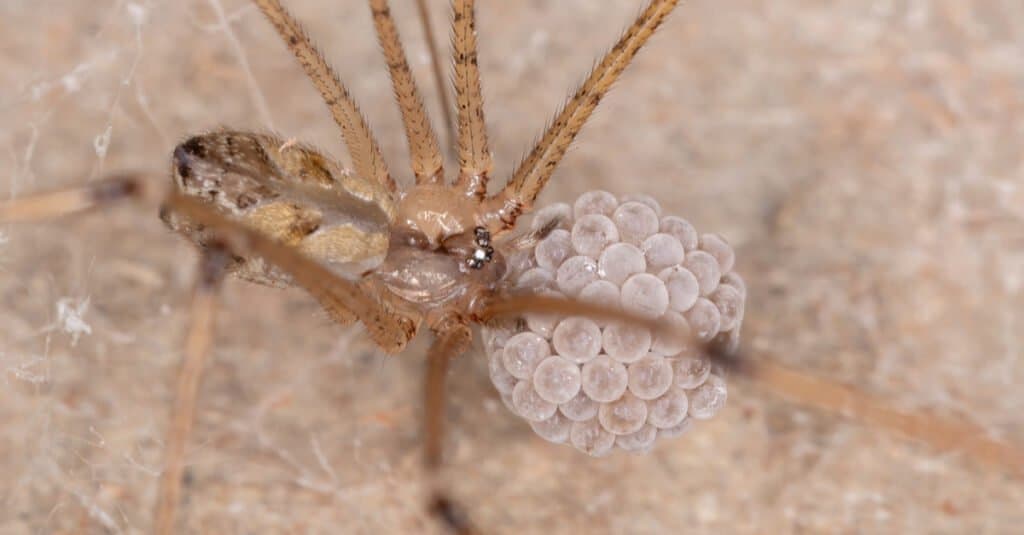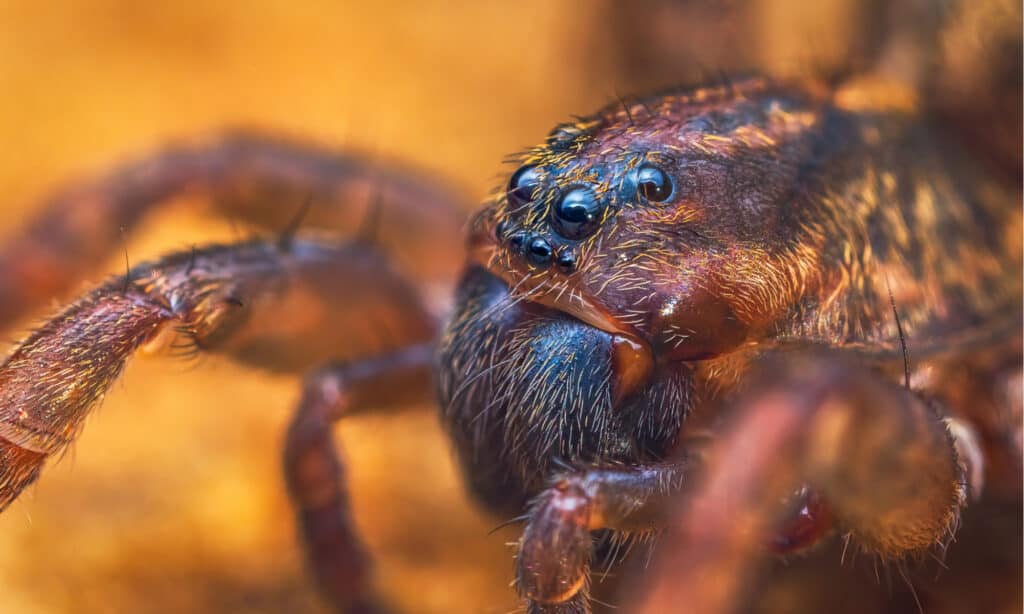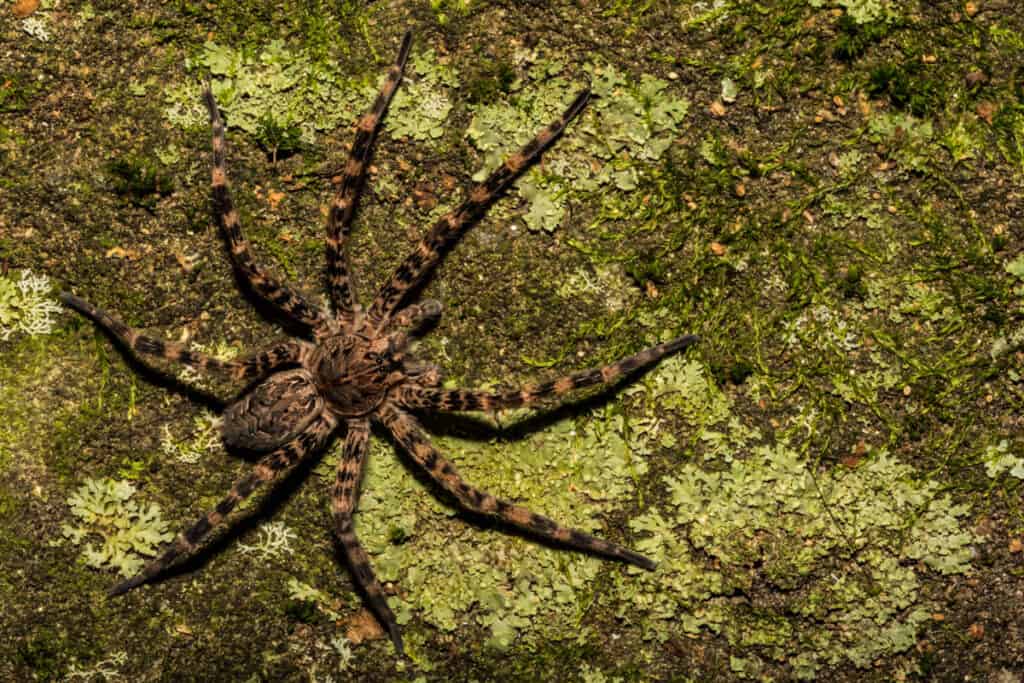People come to South Dakota as tourists looking to experience a unique part of American culture in the national parks and to take in the diverse landscapes that comprise the state. The wildlife in this state is just as varied and distinct as the land they inhabit. The state has bison, bears, coyotes, and other incredible creatures, including spiders. For our purposes, we are going to focus on the biggest spiders in South Dakota to show you that some of the coolest animals are the ones you can hardly see.
What Are the Biggest Spiders in South Dakota?
We’ve come up with a list of five of the biggest spiders in South Dakota. We’ve done our best to gather a list that represents different genera and species. Otherwise, you’d be looking at a list of wolf spiders and fishing spiders.
With that in mind, we’ll show you where these spiders live and what they look like. We’ll also provide information on what to expect if one of them bites you. As you’ll soon see, it’s not the really big spiders that you need to worry about.
5. Long-Bodied Cellar Spider

Cellar spiders are known for their long legs.
©iStock.com/ViniSouza128
| Scientific Name | Size | Danger to Humans |
|---|---|---|
| Pholcus phalangioides | 1-2 inches | A bite may cause a mild burning sensation. |
The long-bodied cellar spider goes by many names, including the skull spider and the daddy long legs. The former name comes from a dark mark on the spider’s carapace that is said to resemble a skull. However, the daddy long legs name is a term given to many creatures, including the harvestman.
Despite what the urban legends may tell you, neither the cellar spider nor the harvestman is dangerous to humans. A bite from this spider will result in mild burning pain that goes away within minutes.
The cellar spider is known for its very long legs, brownish-gray or tan body that is somewhat translucent, and its habit of setting up webs in basements, garages, and other areas where it will not be bothered. If you get close to this spider, it may move around inside its web to become harder to spot.
Cellar spiders are harmless, and they actually help control harmful insect populations, including black widow spiders. Perhaps consider giving these arachnids a pass.
4. The Hobo Spider

The hobo spider is not as dangerous as initially believed.
©SNEHIT PHOTO/Shutterstock.com
| Scientific Name | Size | Danger to Humans |
|---|---|---|
| Eratigena agrestis | 1-2 inches | A bite can cause moderate pain and some redness at the site, but they’re not deadly. |
The hobo spider was once believed to be capable of inflicting a necrotic bite, but modern research says otherwise. A study of 33 confirmed hobo spider bites showed that they did not have clinically significant effects on humans.
The hobo spider can vary in appearance, but it is usually brown or dark brown with chevron patterns on the abdomen. As a result of its very common appearance, it is often confused for other spiders. That is part of what makes understanding the impact of their bites difficult.
That being said, hobo spiders tend to live in places where they can build their funnel webs, like the gaps in a wood pile. They prefer dark areas in homes like basements and crawl spaces. You can avoid interactions with these spiders by looking before reaching around in basements and other dark spots where they can lurk.
3. Black and Yellow Garden Spider

Black and yellow garden spiders spin a unique, zigzag web.
©iStock.com/DianaLynne
| Scientific Name | Size | Danger to Humans |
|---|---|---|
| Argiope aurantia | 0.5-3 inches | Rarely bites humans, but it may cause pain and swelling. |
The black and yellow garden spider is known for its beautiful and unique body and webs. This spider has a silver-colored carapace and head along with an abdomen that is patterned with black and yellow and sometimes silver or gray. Its legs are usually light brown or yellow on the femur and black or banded black and brown starting on the tibia.
The black and yellow garden spider makes a unique web that can measure several feet in diameter. In the middle of their web, they’ll make a stabilimentum, a thick, zig-zag-shaped portion where they wait for prey. They are often called the “writing spider” as a result of that portion of their webs.
You’ll find these spiders around vegetation like bushes, but you may also see them building webs between other structures outdoors. They can give you a mildly painful bite that leaves swelling if you disturb or otherwise antagonize them.
2. Ground Wolf Spider

The ground wolf spider hunts its prey on the ground.
©Lukas Jonaitis/Shutterstock.com
| Scientific Name | Size | Danger to Humans |
|---|---|---|
| Trochosa terricola | 2-3 inches | Delivers a mildly painful bite that leaves a bump. |
The ground wolf spider is not as large as the Carolina wolf spider, but it can still measure up to 3 inches, including its legspan. When they carry their young on their backs, they look even larger and may bear a passing resemblance to a tarantula. That makes it one of the biggest spiders in South Dakota, and also one that people tend to worry about.
Unlike many spiders that build webs to hunt prey, the ground wolf spider and other members of its family hunt them along the ground. They’ll hide in small burrows, under rocks, and in thick vegetation to find their prey.
They have a brown and black body with a light band in the middle of the cephalothorax and darker patterns on either side, along with a mottled abdomen with a dark cardiac mark in the middle. A wolf spider’s bite is painful and may leave an itchy bump behind. Some people are allergic to their venom and require medical attention, but the vast majority of people do not.
1. Dark Fishing Spider

The dark fishing spider can run across the surface of the water or dive into the water to catch prey.
©iStock.com/JasonOndreicka
| Scientific Name | Size | Danger to Humans |
|---|---|---|
| Dolomedes tenebrosus | 3.5-4.5 inches | Can bite humans and cause pain similar to a bee sting. |
The dark fishing spider is the biggest spider in South Dakota. This creature has a legspan of 4.5 inches long, and it often rests on trees or docks with its legs completely stretched out. Its massive profile scares people, especially when they learn that the spider is speedy.
Don’t worry, though. Their large size doesn’t make them capable of harming people. Instead, if you somehow managed to get bitten by this spider, it will feel like you were stung by a bee.
The dark fishing spider has a mottled brown and black body in many cases, but it can also be gray and tan as well. It has W-shaped patterns on the abdomen that helps people identify them. You’ll find them on the ground in forests, usually near bodies of water. Dark fishing spiders spend a lot of their time near water, but they wander farther from water sources than other members of their genus.
We’ve talked about the biggest spiders in South Dakota. Before we go, let’s go over the most dangerous ones. This state is home to the brown recluse and the black widow. It’s important to learn how to identify them and how to get them out of your home without putting yourself in danger, even if that means getting professionals to come to help you.
Up Next:
- 5 of the Biggest Spiders in Wisconsin
- 5 of the Biggest Spiders in Minnesota
- 5 of the Biggest Spiders in Oklahoma
The photo featured at the top of this post is © iStock.com/ViniSouza128
Sources
- Utah State University (1970) extension.usu.edu/pests/uppdl/hobo-spiders
- Missouri Department of Conservation (1970) mdc.mo.gov/discover-nature/field-guide/black-yellow-garden-spider
- National Wildlife Federation (1970) nwf.org/Educational-Resources/Wildlife-Guide/Invertebrates/Yellow-Garden-Spider
- Missouri Department of Conservation (1970) mdc.mo.gov/discover-nature/field-guide/dark-fishing-spider
Thank you for reading! Have some feedback for us? Contact the AZ Animals editorial team.






